Spring veggie pros know how to cook asparagus to maximize its delectably sweet, earthy flavor. You can learn to do it, too, with some simple tips and inspiration.
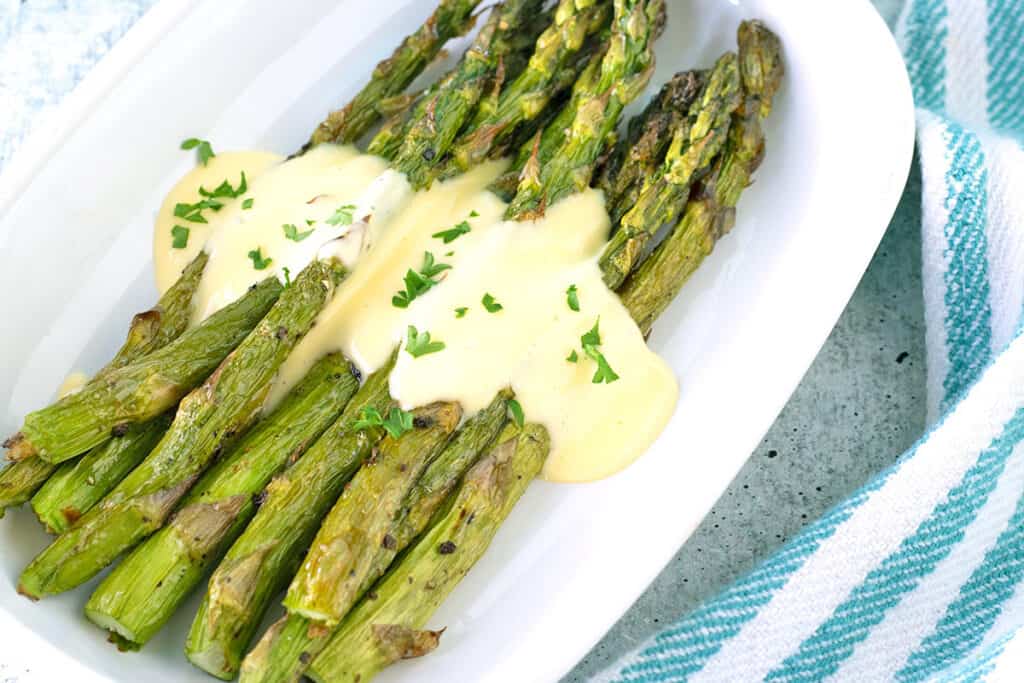
From roasting or smoking, to stir-fries or veggie noodles, asparagus is a versatile and delicious vegetable with a myriad of cooking possibilities.
Asparagus is packed with nutrients. It’s at its peak in-season flavor during April and May. Though, depending on the growing zone, you may see those first delicious spears popping through the soil in asparagus beds as early as February and as late as June.
Green asparagus is actually available almost year-round in the United States. However, in what is the off-season for most of us, it has to be shipped in from great distances.
That off-season shipping time can reduce the sweetness and alter flavor since the sugars in asparagus start converting to starch as soon as the stalk is cut. It also increases the cost.
Choose locally grown, in-season asparagus for the most delicious results in your favorite recipes. Then, master how to cook asparagus with the tips and info provided below.
Types of Asparagus
Did you know there are four different types of asparagus?
- Green Asparagus — Green asparagus grows above ground and has a sweet, earthy, grass-like flavor with mild bitter undertones. It’s the variety we are most familiar with in the U.S. Green asparagus spears are bright green and may have some patches of purple on them.
- White Asparagus — White asparagus is actually green asparagus that is grown with a different method. Earth is mounded up over the spears to prevent them from receiving any sunlight. The absence of light means the plants don’t produce chlorophyll and so remain white. White asparagus has a milder flavor with the same slightly bitter undertones.
- Purple Asparagus — Purple asparagus is its own variety. It was developed in Italy and is not as common in the U.S., but can sometimes be found in farmers’ markets or at produce stands. Purple asparagus is white or pale green on the inside. It has more sugar in its spears than green or white asparagus. Because of that, purple asparagus has a sweeter, nutty flavor
- Wild Asparagus — Wild asparagus is a perennial green that grows more often in rural areas. It grows near water, but not in it. And it needs access to full sun. Those are the best clues for where to search for it. Wild asparagus is a forager’s dream. It often has a sweeter and deeper flavor than commercially grown asparagus and stalks are thin.
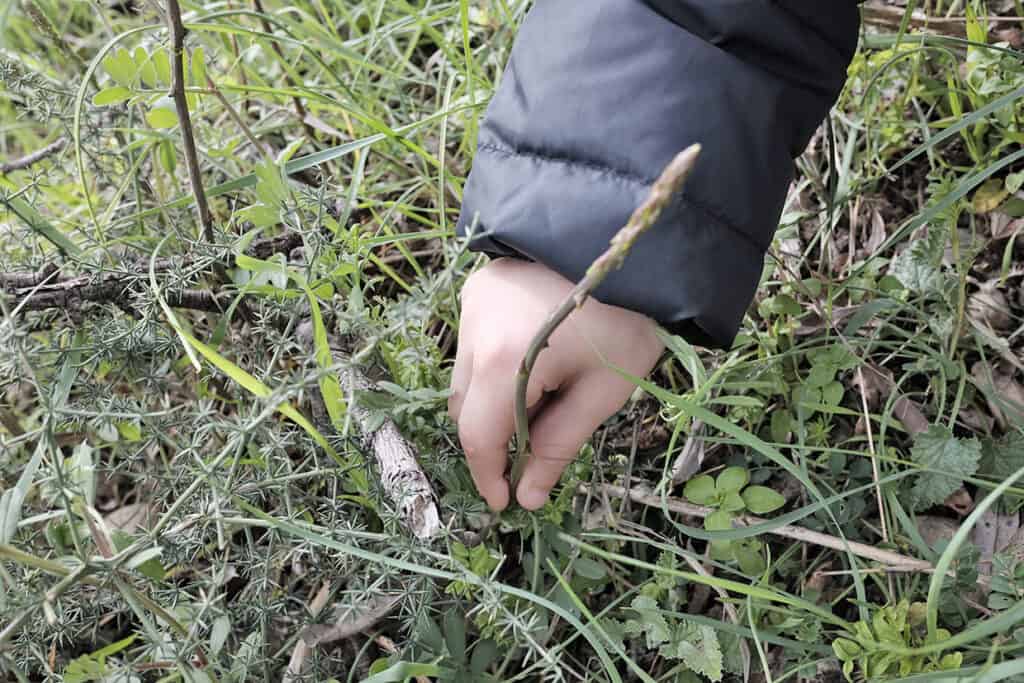
How To Choose Fresh Asparagus
When buying asparagus, there are key things to look for.
Firm and Straight — The spears should be firm and round, with tightly closed tips. The stalks should be relatively straight, not curved. Limp or floppy stalks haven’t been stored well.
Vibrant Color — The color should be vibrant whether you are buying green, white, or purple varieties. Faded color can indicate old produce.
Moisture — The bottom of the spears should be moist and plump. If you notice a woody texture or dried out appearance at the bottom of your asparagus spears they may be too old. Dryness can also mean the asparagus wasn’t stored properly.
Spear Diameter — Size can affect tenderness, sweetness, and the aesthetic on a plate. Thin asparagus spears may be prettier in some presentations. They tend to be very tender and more sweet than thicker stalks. However, thicker stalks give you great flavor, more food for the money, and may be the perfect backdrop on your plate. Buy according to how and why you’re preparing it and what you’ll be serving it with.
Stored Properly — The best grocers will store fresh asparagus upright in a shallow container of water.
FDL’S 75 Best Bites

Our cookbook with 75 tasty recipes will be your go-to kitchen companion for easy dinners with ad-free recipes right at your fingertips. Crafted by experienced chefs and recipe developers, this collection offers a treasure trove of tried-and-true dishes that make mealtime a breeze.
Get the Recipe: FDL’S 75 Best Bites
How To Store Fresh Asparagus
Wash — Wash the asparagus spears in cold water and then dry them thoroughly.
Prep — The first thing you should do after washing your asparagus is to prep it for storage by following these tips.
Trim Ends — Begin by removing about one-half inch off the bottom of each spear.
If you chose healthy, moist asparagus, that should be all that’s necessary to get any dry ends off. You can use a knife to remove the ends. However, Gen LaRocca creator and recipe developer at “Two Cloves Kitchen” suggests, “Feel for the edge of the thick, woody portion of the asparagus stem by hand. It should easily snap when you’ve reached the tender part of the asparagus spear.”
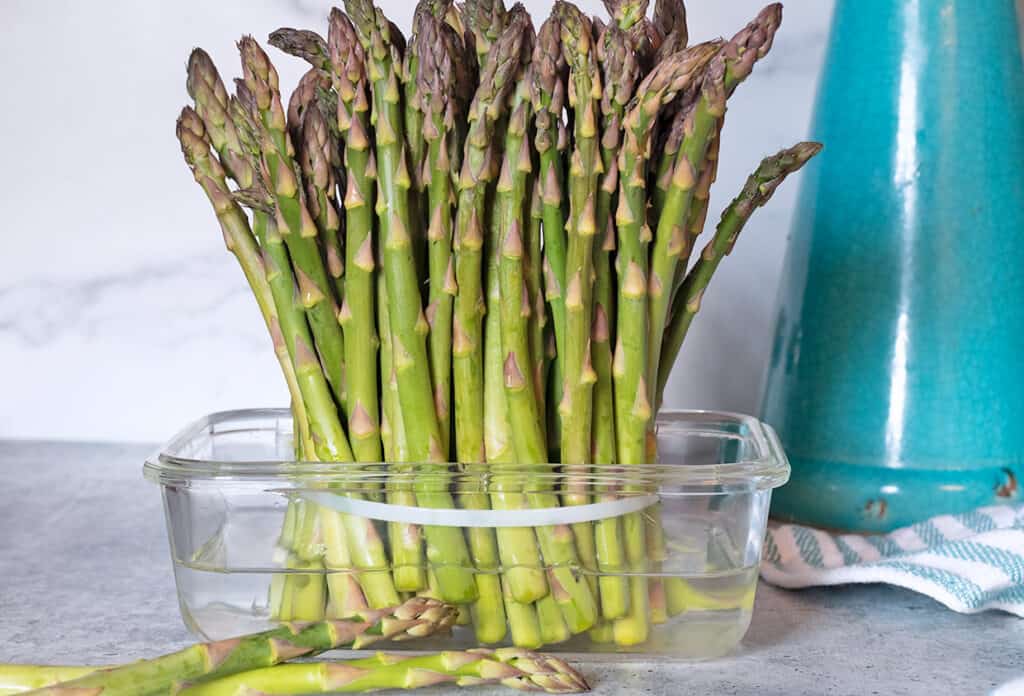
Upright in Water — Stand your asparagus upright in a container with around one inch of water in the bottom. The water should just cover the ends of your spears. Don’t overfill it.
Store in Fridge — Place the container of cleaned asparagus spears in the fridge.
Change Water — If you have stored them for longer than two days, check the asparagus stalk ends again and then stand them in clean, fresh water, before returning them to the fridge.
Storing Cooked Asparagus
To store cooked asparagus, use airtight food containers and store in the fridge for a maximum of four days. Cooked asparagus becomes softer the longer it is stored.
Can I Eat Asparagus Raw?
Yes. While there are many dozens of recipes for ways to cook asparagus, you can definitely enjoy it raw, as well.
Asparagus is great for dipping and snacking. Plus, Spring salads are fantastic when raw, chopped asparagus is added.
Should I Peel Asparagus?
Fresh green asparagus is usually fine to cook with no other prep other than washing and removing the ends.
However, the bottom two-thirds of white asparagus stalks must be peeled before cooking.
Green Asparagus that is not as fresh or is harvested late in the season may also need to have the stalks peeled if they have become tough and fibrous.
Once peeled, even tougher asparagus spears may be cooked, as usual.
How To Cook Asparagus
Cooking asparagus is very simple. But, if you don’t use the proper cooking techniques, it can turn out badly. If you’ve ever eaten watery, limp spears of asparagus or spears where the stalks have gone mushy, you know that it’s important to cook it properly.
Whatever cooking method you choose, cook asparagus just until it is tender when pierced with a fork. Green, purple and wild asparagus should still be bright green in color and have a tender-crisp bite. Yes, sadly, that gorgeous purple asparagus turns green when cooked.
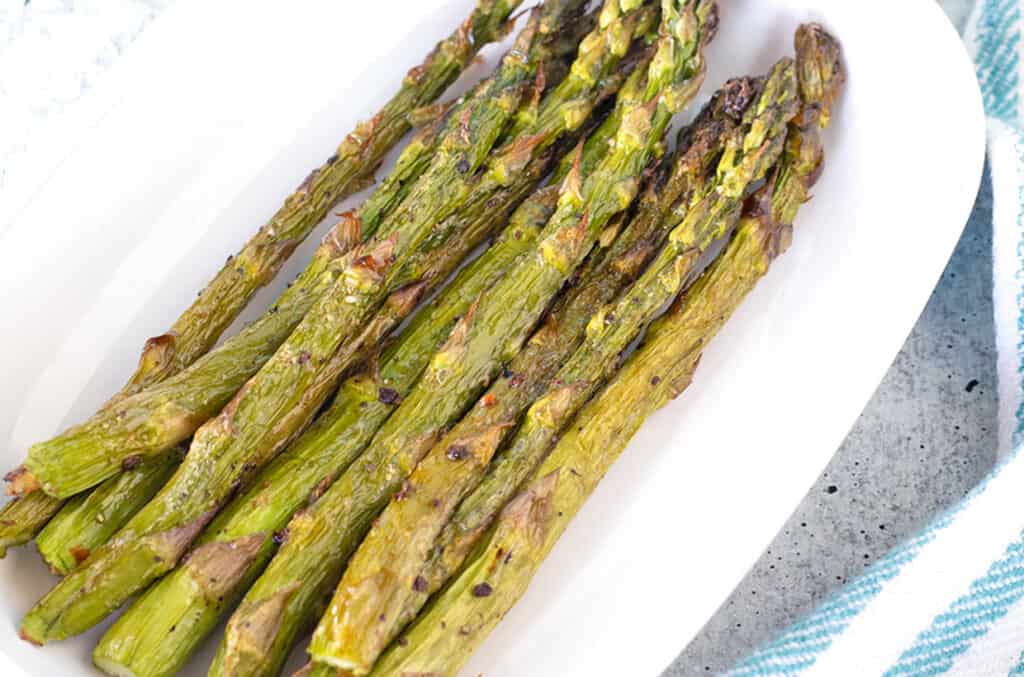
White asparagus stays white after cooking. Because it is thicker and more fibrous, however, it requires a longer cooking time than purple or green asparagus. White asparagus should be cooked separately from other varieties.
Whenever possible, avoid immersing asparagus in water. Boiling is my least favorite way to cook asparagus. The asparagus takes on water, loses nutrients and flavor into the water it’s boiled in, and becomes soggy and unappealing very easily.
Instead, try one of these delicious cooking methods.
Methods for Cooking Asparagus
- Air Fryer Asparagus — Preheat the air fryer to 400°F. Toss asparagus spears with oil, salt, and pepper. Place spears in a single layer in the air fryer basket. Air fry for six to eight minutes until the outside is crisp and the stalks are tender.
- Broiled Asparagus — Preheat the broiler to high. Toss stalks of asparagus with oil and your desired seasoning. Broil for three minutes. Turn. Broil an additional two to three minutes, until the asparagus is tender when pierced with a fork.
- Grilled Asparagus — Preheat the grill to between 350°F and 400°F. Place the asparagus that has been tossed in your recipe ingredients across the grill grates. Close the lid and cook for seven to nine minutes, until the asparagus is crispy on the outside and tender on the inside.
- Oven-Roasted Asparagus — Toss asparagus spears in oil and the seasonings you prefer. Add them to a sheet pan and place in a preheated 425°F oven. Roast for around 10 minutes.
- Steamed Asparagus — Use a steamer pan set. If you don’t have one, you can place a heat-proof strainer or a rack over the pan. You want the asparagus to be above the water level and not touching it. Place about two inches of water in the bottom of the pan. Add the rack, steamer basket or strainer over the water. Bring the water to a boil. Add the asparagus to the basket or rack. Steam the asparagus for five to 10 minutes, until it is bright green and tender. Toss the asparagus in butter, salt, and pepper.
- Stir-Fried Asparagus — Cut asparagus spears into pieces about three inches long. Heat oil in a wok or skillet until it just begins to smoke. Add the asparagus along with salt and pepper. Fry until asparagus is tender but still bright green. Add one half teaspoon each of grated ginger and minced garlic and a quarter teaspoon red pepper flakes. Stir fry for 30 more seconds and then serve.
- Smoked Asparagus — Preheat the smoker to 225°F. Toss asparagus spears with oil, salt, and pepper and place in a grill basket. Smoke for about one hour.
What To Serve With Asparagus
Asparagus is sweet, fresh, and earthy. It’s a perfect complement to many favorite main dish recipes or to add pizzazz to your pasta recipes.
Since you know how to cook asparagus now, you can serve it with chicken recipes, in salads, on
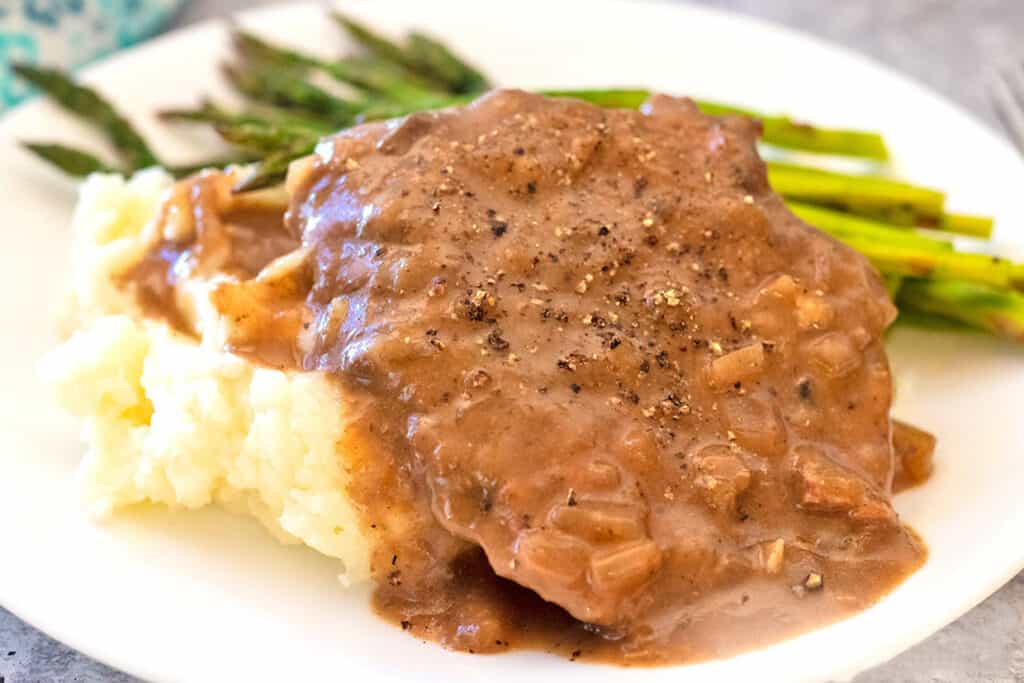
You’ll be able to serve asparagus alongside slow cooker meals or your favorite casseroles.
It’s a wonderful side dish for pork recipes, lamb, or fish.
And since you know how to cook asparagus you’ll be able to take advantage of this nutritious garden gem in all your Spring menus. It’s an affordable and tasty in-season option for Spring and early Summer.
So grab a bundle of asparagus the next time you’re at the market. Experiment with a new recipe and enjoy adding these emerald beauties to your next delicious dinner.
Glenda is the creator and recipe developer at Glenda Embree blog. She believes cooking from scratch doesn’t need to be complicated. She happily shares family favorite recipes and teaches readers how to make homemade food an easy and affordable option in their own kitchens.